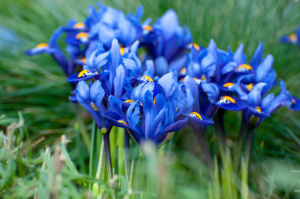Iris: the flower with a message
The Iris is not only unique; you could even call it magical. It can be found in every colour of the rainbow including the most stunning colour of all: blue. Did you know that there are both large-flowering and small-flowering irises?
Rainbow
The name ‘iris’ is Greek for ‘rainbow’. And a very apt name it is since irises come in every colour of the rainbow. Besides the literal meaning of the word ‘iris’, Iris is also a character from Greek mythology. This was the goddess who transferred messages between the gods and people. To do so, she slipped down from heaven to earth on a rainbow. And this is also the source of the Iris’ symbolic meaning: ‘I have a message for you’.
Straight into its heart
The enchanting Iris belongs to the Iris family and was first mentioned around 1500 BC. This charismatic flower has three petals. As it opens slowly but surely, you can you look straight into its heart. The natural beauty of irises adds a beguiling element to a garden, and their colours are bright and expressive. In addition to their various blues, irises are also available in yellow, lilac, purple, brown and white. Some even sport two colours.
Groups
Bulbing irises are classified into two groups: the large-flowering and the small-flowering irises. Large-flowering irises grow to a height of 50 to 70 centimetres and produce flowers in May and June. The small-flowering irises are also known as dwarf irises. These produce small flowers with intricate markings, grow to only 15 centimetres in height, and bloom in February and March. The leaves of both groups are tubular and pointed.
Planting
If you want to enjoy magnificent irises in your garden early in the spring, be sure to plant them in the autumn. Large-flowering irises should be planted in a sunny position, at a depth of 5 centimetres and at 8 centimetres apart. If your region has harsh winters, protect them with a layer of straw. Small-flowering irises will bloom profusely in either sunny or semi-shady locations. Plant these bulbs three times as deep as they are tall. To create a pretty carpet of flowers in the garden, plant them in dense clusters.
- Botanists have discovered more than 200 species of irises. Most of them grow from bulbs while some emerge from rhizomes.
- Perhaps you don’t have a garden. That’s no problem either since irises can also be planted in containers on balconies and patios.
- Varieties of Iris hollandica are commonly grown for their cut flowers. This makes them a fine choice for your cutting garden.
- In addition to bulbing irises, there are also irises that grow from rhizomes. These perennial plants are varieties of Iris germanica.
Source: iBulb
Frequently Asked Questions (FAQs) about Iris Flower Bulbs
1. What are Holland Iris flower bulbs, and how do they differ from other types of flowers?
Iris flower bulbs are a type of perennial bulbous plant known for their striking, unique flowers. Unlike many other flowering plants, Irises grow from bulbs rather than seeds or rhizomes. These bulbs store energy and nutrients, allowing the Iris to bloom year after year. Irises are recognized for their distinctive petal arrangement, with three upright petals called “standards” and three drooping petals called “falls.” They come in a wide range of colors and varieties, making them a popular choice among gardeners.
2. When is the best time to plant Iris flower bulbs, and how should I care for them?
The ideal time to plant Iris flower bulbs is in late summer or early fall, typically between August and October, when the soil is still warm. Choose a location with well-draining soil and partial to full sunlight. Plant the bulbs about 2-4 inches deep and space them 4-6 inches apart. After planting, water them thoroughly. Irises are relatively low-maintenance; they require minimal pruning, regular watering during dry spells, and occasional fertilization. Be sure to remove dead foliage to prevent disease and promote healthy growth.
3. Can I grow Iris flower bulbs in containers or pots, and what should I consider when doing so?
Yes, you can grow Iris flower bulbs in containers or pots, which is especially useful for those with limited garden space. Choose a container with good drainage and use a well-draining potting mix. Plant the bulbs at the same depth as you would in the ground, ensuring they have enough room to grow. Containers should be placed in a location with adequate sunlight. Keep in mind that potted Irises may require more frequent watering, as containers tend to dry out faster than garden soil.
4. Do you sell Iris flower bulbs in your online store, and how can I order them?
Yes, we offer a variety of Iris flower bulbs for sale in our online store. To order, simply browse our selection, choose the Iris varieties you desire, and add them to your cart. Then, proceed to the checkout, where you can enter your shipping and payment information. We offer secure online payment options for your convenience. Once your order is confirmed, we’ll ship the Iris bulbs to your specified address, ensuring they arrive in prime planting condition.
5. What are some common pests and diseases that can affect Iris flower bulbs, and how can I protect my plants?
Irises can be susceptible to pests such as aphids, iris borers, and slugs, as well as diseases like iris leaf spot and root rot. To protect your plants, practice good garden hygiene by removing debris and dead foliage regularly. Use organic or chemical treatments as necessary to combat pests and diseases. Additionally, ensure proper spacing between plants to improve air circulation and reduce the risk of fungal infections. Vigilance and timely action are key to maintaining healthy Iris flower bulbs.
Published: 07.08.2020
